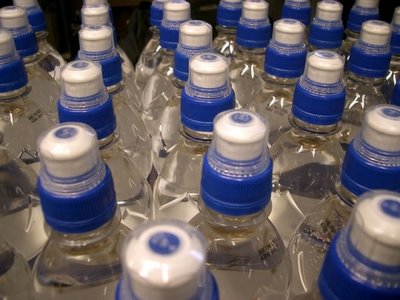
Hello again.
And while I was there, this new president dude was sworn in and he's already making all kinds of radical changes.
For example, it turns out President Obama didn't think much of his predecessor's policies as they relate to this global warming thing threatening the existence of life on Earth. Turns out, he's against it and intends to adopt a "pro-Earth" policy. Who knew?
So among the first things he intends to do once he'd finally mastered that pesky Oath of Office (both he and Chief Justice Roberts have pledged to take remedial Swearing In classes) was to issue executive orders increasing fuel efficiency standards on automobiles and to allow states to impose limits on carbon dioxide, something the Bush administration rejected.
As
Reuters reported here, "if the EPA reverses the previous ruling, more than 12 U.S. states could proceed with plans to impose strict carbon dioxide limits. California wants to reduce the emissions by 30 percent by 2016 -- the most ambitious federal or state effort to address global warming."
Obama "is scheduled to deliver remarks on jobs, energy independence and climate change in the East Room of the White House on Monday," Reuters reported.
By March, he wants the Department of Transportation to set the new mileage guidelines, that will be in effect by 2011.
As
The New York Times reported here, once states freed to enact standards do so, "automobile manufacturers will quickly have to retool to begin producing and selling cars and trucks that get higher mileage than the national standard, and on a faster phase-in schedule. The auto companies have lobbied hard against the regulations and challenged them in court."
Seems to me, those auto makers have a choice, get with the program or give back the bailout money. It's not as if they haven't seen this coming for years. Hell, if they had spent half the money re-tooling their plants that they've spent on lawyers fighting the obvious need to re-tool their plants, their plants would be re-tooled by now.
(Strange, don't you think, how the words "tool" and "auto companies" keep coming up in the same sentence?)
Not satisfied there, Obama "will also order federal departments and agencies to find new ways to save energy and be more environmentally friendly. And he will highlight the elements in his $825 billion economic
stimulus plan intended to create jobs around renewable energy," the New York Times reported.
Speaking of which, let's consider how well that might work. If only there were some kind of real-life example we could turn to....hmmmm.
If only there were some sort of report showing how green technology might affect growth...
We take you now good citizens to
the pages of the Los Angeles Times where we find evidence of -- wait for it -- yes! a report on a report that shows how green technology might affect growth.
In two words or less -- "very well."
The report, by a non-profit research group called Next 10, found "Green-collar jobs are growing faster than statewide employment. Clean-tech investment in the state hit a record last year, despite steep stock-market declines. California leads the nation in patent registrations for green technology. Efficiency measures pioneered (in California) over the last three decades have created 1.5 million jobs and allowed California businesses to generate many more goods and services per unit of energy consumed than other states."
"Those green jobs encompass a variety of occupations, including research scientists, wind-energy technicians and solar panel installers. Such positions are growing fast, the report showed. Green employment was up 10% between 2005 and 2007. Statewide job growth was 1% over the same period," The LA Times reported.
California has already adopted the toughest energy efficiency standards in the country. "The result is that the state's energy productivity -- energy consumed compared with economic output -- is 68% higher than that of the rest of the country, according to the report."
"Venture capital investment in clean technology in California totaled $3.3 billion in 2008, more than double the amount invested in 2007. Between 2002 and 2007, 607 green-technology patents were registered in California, the study said. That's more than any other state," the LA Times reported.
Hm. And all without cutting taxes for rich people.
But really, who can believe some wacky non-profit with a weird name out on the left coast?
OK, would you believe Wal-Mart?
"After blanketing the country with its giant, all-in-one stores, it began cannibalizing its own sales. Older stores looked tattered and tired, and Wal-Mart’s flirtation with higher-end merchandise, like skinny jeans with fur trim, alienated low-income shoppers who preferred unadorned basics. "
So CEO H. Lee Scott Jr. did what smart business people do, he stepped back, looked at the big picture, saw the future and then, by virtue of what the Times calls Wal-Mart's "Herculean size," it led.
"By virtue of its herculean size, Wal-Mart eventually dragged much of corporate America along with it, leading mighty suppliers like
General Electric and
Procter & Gamble to transform their own business practices.
"Today, the roughly 200 million customers who pass through Wal-Mart’s doors each year buy fluorescent light bulbs that use up to 75 percent less electricity than incandescent bulbs, concentrated laundry detergent that uses 50 percent less water and prescription drugs that contain 50 percent less packaging," the Times reported.
"By selling only concentrated liquid laundry detergent, an effort it began last year, Wal-Mart says, its customers will save more than 400 million gallons of water, 95 million pounds of plastic resin, 125 million pounds of cardboard and 520,000 gallons of diesel fuel over three years," the paper reported.
"Wal-Mart says it now saves itself $3.5 million a year just by recycling loose plastic and selling it to processors. After changing the design of its trucks and how efficiently it loads them, its fleet had a 25 percent improvement in
fuel efficiency. Amory B. Lovins, a MacArthur fellow and chairman and chief scientist of the Rocky Mountain Institute, a nonprofit research organization, said Wal-Mart would save nearly $500 million a year in fuel costs by 2020. "
So, "as the saying goes, Wal-Mart has also done well by doing good. Along with the
McDonald’s Corporation, it was one of only two companies in the Dow Jones industrial average whose share price rose last year.
"Profits climbed to $12.7 billion in the 2008 fiscal year, from $11.2 billion in the 2006 fiscal year, while sales jumped to $375 billion, from $312.4 billion, during the same period" and this as the recession was beginning to take hold.
Hmm, Go Green, Make Green.
You can use that if you want.
Labels: auto industry, Barack Obama, global warming, mileage, Wal-Mart

 RSS
RSS




